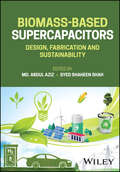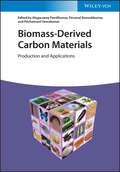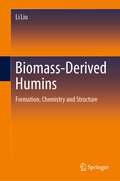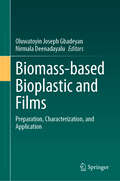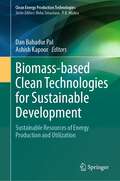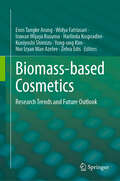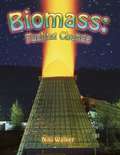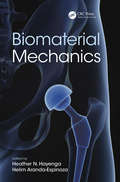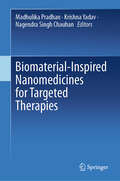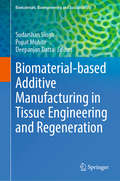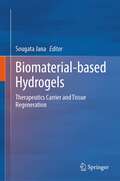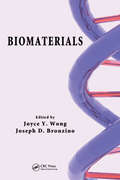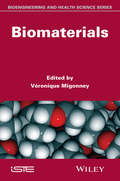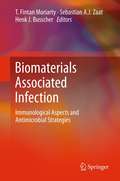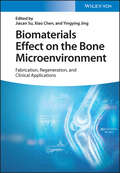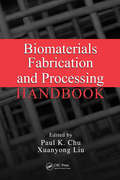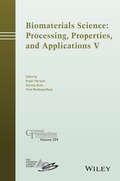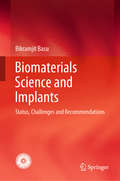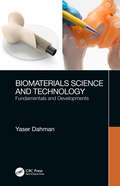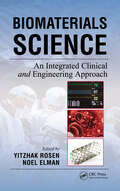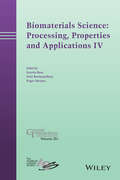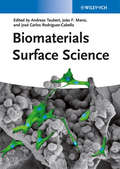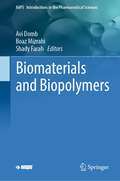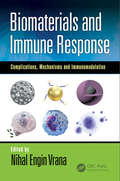- Table View
- List View
Biomass-Based Supercapacitors: Design, Fabrication and Sustainability
by Syed Shaheen Shah Md. Abdul AzizBIOMASS-BASED SUPERCAPACITORS Authoritative resource addressing the fundamentals, design, manufacturing, and industrial applications of supercapacitors based on biomass Biomass-Based Supercapacitors presents a systematic overview and recent developments in the research, design, and fabrication of supercapacitors using biomass, discussing fundamentals, advancements, industrial applications, and the manufacturing process of biomass-derived supercapacitors. The text also considers environmental and economic aspects of the technology, along with biomass-based supercapacitors in the context of circular economy. Written by a team of international experts in the field of supercapacitors, Biomass-Based Supercapacitors covers sample topics such as: Basic foundational knowledge surrounding supercapacitors, electrochemical techniques for supercapacitors, and different types of supercapacitors Biomass derived electrode materials for supercapacitors, such as activated and non-activated carbon, carbon from pretreated biomass, carbonate salts-activated carbon, and more Electrolytes, separators, and packaging materials for supercapacitors using biomass and binding materials from biomass for supercapacitors Future outlooks and challenges for the development of biomass-based supercapacitors, from the lab to practical applications in industry Biomass-Based Supercapacitors is an excellent resource for academic researchers and industrial scientists working in the areas of supercapacitor fabrication, energy materials and energy storage devices, electrochemistry, materials science, biomass conversion, green chemistry, and sustainability.
Biomass-Derived Carbon Materials: Production and Applications
by Alagarsamy Pandikumar Perumal Rameshkumar Pitchaimani VeerakumarExplores the sustainable production of carbon materials and their applications Of increasing interest to practitioners and researchers in a variety of areas, biomass-derived carbon materials can be easily produced and possess the large surface areas and porosities that enable many applications in materials science, biochemistry, chemistry, and energy research. In Biomass-Derived Carbon Materials: Production and Applications, a team of accomplished researchers delivers a thorough and up-to-date exploration of the preparation and activation processes of biomass-derived carbon materials, the fabrication of composites, and assorted and multidisciplinary applications of the technology. The book also covers future opportunities for research and application. Introductory chapters provide information about the production, functionalization, and characterization of biomass-derived carbon materials, while the latter parts of this edited volume discuss the applications of biomass-derived carbon materials such as catalysis, sensors, microbicidal activity, toxic chemicals removal, drug delivery, and energy conversion and storage applications. The book also includes: A thorough introduction to the production of biomass-derived carbon materials, as well as their characterization Comprehensive explorations of biomass-derived carbon-based materials for microbicidal applications and carbon-based nanomaterials prepared from biomass for catalysis Practical discussions of biomass-derived carbon quantum dots for fluorescence sensors and mesoporous carbon nanomaterials for drug delivery and imaging applications In-depth examinations of biomass-derived carbon as electrode materials for batteries and porous carbon synthesized from biomass for fuel cellsIdeal for materials scientists as well as industrial chemists and biochemists, Biomass-Derived Carbon Materials: Production and Applications also belongs in the libraries of electrochemists and sensor developers.
Biomass-Derived Humins: Formation, Chemistry and Structure
by Li LiuThis book provides a unique perspective on atom economical utilization of biomass resources into value-added productions. Humins are inevitably formed during the process of biomass conversion, which compete with desired products, restrain the activity of catalyst and hinder the recycling of catalyst and separation of products. To further improve the efficiency of biomass conversion toward downstream products, unambiguous elucidation of the chemical structure and formation mechanism of humins are prerequisite. This book primarily presents the chemical structure analysis and formation mechanism of various biomass-derived humins, from simple molecular models to raw biomass resources. The chemical similarities and differences of various biomass-derived humins have been systematically summarized according to advanced analytical interpretation, which offers a comprehensive viewpoint for readers with chemistry, engineering and material backgrounds. Furthermore, the progress that has been achieved on humins valorization and future perspectives are discussed. Given its scope, this book can be treated as an informative resource for undergraduates, postgraduates, lecturers and researchers interested in biomass conversion from academia and industry from entry to professional levels.
Biomass-based Bioplastic and Films: Preparation, Characterization, and Application
by Oluwatoyin Joseph Gbadeyan Nirmala DeenadayaluThis book provides a platform for researchers, engineers, and manufacturers to conceptualize green ideas for sustainably developing plastics and films from biomass and agricultural waste. The upscaling of sustainable bioplastic production is essential for the economic growth of industries and local communities as a means to tackle waste management issues. Therefore, this book acts as a guide to characterize various methodologies and applications for producing usable bioplastic products that will lift the burden imposed by excessive industrial waste pollution. This framework will not only contribute to support the health and management of local communities impacted by waste pollution, but will also support businesses economically through efficient and sustainable recycling practices. This work will inform readers in academia, business, and government sectors with the knowledge needed to control the waste generated from various sources and transfer them to valuable products.
Biomass-based Clean Technologies for Sustainable Development: Sustainable Resources of Energy Production and Utilization (Clean Energy Production Technologies)
by Dan Bahadur Pal Ashish KapoorThis book explores the comprehensive world of biomass-based clean technologies for sustainable development. The meticulously curated book delves into the latest advancements, process and product development aspects, and socio-techno-economic viability of biomass-derived solutions. The book aims to explore cutting-edge strategies and innovative approaches to revolutionize energy and environmental sectors on a global scale. The book covers a wide range of scientific and technological fields, shedding light on the utilization of agricultural and forest-derived biomass. Multifarious applications in biofuels, biochar, natural composites, construction materials, and value-added chemicals are explored. The book is an attempt to impart knowledge to address challenging aspects like feedstock variability, supply chain management, process optimization, product standardization, environmental impact, net carbon footprint, and economic viability. By fostering interdisciplinary collaboration and harnessing the renewable nature of biomass, this book offers a holistic approach to develop novel and sustainable solutions. Researchers, scientists, engineers, and professionals from diverse backgrounds will find this book to be an invaluable resource. Policymakers and industry leaders seeking to drive the adoption of clean and green technologies will gain crucial insights. Students and academics will benefit from the latest advancements in biomass-based clean technologies, process and product development aspects, and sustainability assessments. This book is an essential companion for those dedicated to shaping a greener future and will inspire public-private collaborations and innovative research endeavours.
Biomass-based Cosmetics: Research Trends and Future Outlook
by Widya Fatriasari Enos Tangke Arung Irawan Wijaya Kusuma Harlinda Kuspradini Kuniyoshi Shimizu Yong-Ung Kim Nur Izyan Wan Azelee Zehra EdisThis book highlights the potential of biomass for cosmetics applications. It covers the discussion on biomass as a source for cosmetics from savanna, marine and tropical forest, trend and market outlook of biobased cosmetics, active substances from biomass for cosmetics, extractives from biomass for cosmetics, other non-wood forest products such as essential oil, tengkawang, and bee pollen. Besides that, the potency of biopolymers such as lignin, and polysaccharides are presented. The book also discusses activated carbon as a cosmetic source. To present more comprehensive information, it covers biomass as anti-aging, anti-acne, sunscreen, anti-melanin, and antimicrobial. Regarding the close contact system with the human in daily life, cosmetic needs to comply with the human system. Therefore, one special chapter is dedicated to presenting the compatibility view of biobased cosmetics in the human body system. Nanomaterials in cosmetics have started to be used by many beauty companies asindicated by nano-related patents. The nanotechnology applications in cosmetics also provide future trends in bio-based cosmetics. Some forms of nanomaterials that have been reported include liposomes, nanoemulsion, nanocapsules, solid lipid nanoparticles, nanocrystals, nano-silver, nano-gold, hydrogel, etc. Iodinated Aloe Vera formulations within polymeric complexes present examples of bio-antimicrobials and such compounds are at the crossroads between pharmaceutics and cosmetics. Finally, the environmental and safety impacts of biobased cosmetic development are discussed as the closure in the last chapter.This book is expected to provide insightful information for those dealing with biomass or doing research on biomass for sustainable living. Moreover, it is also suitable for policymakers to get the new and latest information on valorizing local biomass while expanding its usage for cosmeceutical purposes. Due to the current environmental problems occurring in our surroundings, this book is seen to be an important tool to spread awareness of the smart way of utilizing our precious biomass and transforming it into valuable products.
Biomass: Fueling Change
by Niki WalkerDid you know that some cars are run on fuel made from the oils from sunflowers and soybeans? Biomass: Fueling Change is an exciting new book that explores bioenergy, energy derived from organic matter, to produce heat, run cars, and generate electricity. Worldwide case studies and colorful photographs and illustrations will help children learn about the history of bioenergy and how the world is using this energy today.
Biomaterial Mechanics
by Helim Aranda-Espinoza Heather HayengaThis book describes the fundamental knowledge of mechanics and its application to biomaterials. An overivew of computer modeling in biomaterials is offered and multiple fields where biomaterials are used are reviewed with particular emphasis to the importance of the mechanical properties of biomaterials. The reader will obtain a better understanding of the current techniqus to synthesize, characterize and integrate biomaterials into the human body.
Biomaterial-Inspired Nanomedicines for Targeted Therapies
by Nagendra Singh Chauhan Madhulika Pradhan Krishna YadavThis book delves into the burgeoning field of nano-biomaterials and their application in targeted drug delivery across various therapeutic domains. Through its comprehensive exploration, it offers insights into the innovative approaches and potential of biomaterial-inspired nanomedicines in revolutionizing healthcare. Chapter 1 introduces readers to the fundamental concepts of biomaterial-inspired nanomedicines, laying the groundwork for subsequent discussions. Chapter 2 delves into the utilization of nano-biomaterials in tissue engineering, highlighting their role in regenerative medicine. The book further examines the targeting of specific physiological barriers, such as the blood-brain barrier (Chapter 3), and explores the opportunities and challenges in biomaterial-based vaccine delivery (Chapter 4). Additionally, it discusses the use of nano-biomaterials in addressing pulmonary obstruction (Chapter 5) and targeting the tumor microenvironment for chemotherapy (Chapter 6). Chapters 7 to 16 explore various therapeutic applications of nano-biomaterials across different medical conditions, including autoimmune skin disorders, diabetes, wound healing, central nervous system disorders, ocular diseases, infectious diseases, musculoskeletal disorders, and gastrointestinal diseases. Furthermore, the book sheds light on advances in nano-biomaterials for effective antimicrobial therapy and offers insights into the clinical and regulatory considerations associated with their use (Chapter 17). By encompassing a wide range of topics and providing in-depth analyses, "Biomaterial-Inspired Nanomedicines for Targeted Therapies" serves as a valuable resource for researchers, practitioners, and policymakers aiming to leverage the potential of nano-biomaterials in improving healthcare outcomes.
Biomaterial-based Additive Manufacturing in Tissue Engineering and Regeneration (Biomaterials, Bioengineering and Sustainability #7)
by Sudarshan Singh Popat Mohite Deepanjan DattaBiomaterials are substances that are engineered to interact with biological systems for medical and therapeutic purposes. Biomaterial-based additive manufacturing in tissue engineering is a rapidly evolving field with ongoing research and development. As technology advances, it is likely to play a pivotal role in the development of regenerative medicine and personalized healthcare. Biomaterial-based additive manufacturing, also known as 3D bioprinting utilizing biodegradable or bioavailable polymeric materials, is a cutting-edge technology with great potential and promise for tissue engineering and regeneration. This innovative approach combines biomaterial or engineered biomaterials with precise or customized printing to develop a complex three-dimensional structure that mimics the architecture and functionality of native tissues. An important aspect in development of 3D printed products for tissue engineering or regeneration is selection of biomaterials, development of bio inks using those biomaterials, cell integration, customization, vascularization, and biodegradability of the product. Although 3D bioprinting has shown promise in various applications with potential to revolutionize organ transplantation and tissue engineering, there are several challenges such as ensuring proper vascularization, improving the mechanical properties of printed products, and addressing regulatory aspects with ethical consideration. Therefore, in this book emphasis on tissue engineering and regeneration will be presented, which is an interdisciplinary field that aim to restore, repair, or replace damaged or lost biological tissues. Moreover, chapters inform on recent shift in research that indicates a customized fabrication of biodegradable products, the future of tissue engineering and regeneration.
Biomaterial-based Hydrogels: Therapeutics Carrier and Tissue Regeneration
by Sougata JanaThis book highlights recent advances in natural and synthetic biomaterials-based hydrogel for drug delivery carriers and tissue engineering. It covers key topics such as chitosan, alginate, gelatin, cyclodextrin, cellulose, starch, hyaluronic acid, dextran, collagen hydrogel, Injectable hydrogel magnetic hydrogel, DNA-based hydrogels, 3D printing of hydrogels, hydrogel for bone tissue engineering and regenerative medicine, etc. Each chapter develops a particular aspect of recent advances in biomaterial-based Hydrogels delivery systems to cover the importance, fabrication technology, characterization, evaluation, delivery of therapeutic and biomedical applications, and future perspectives. Written by a group of renowned scientists, chemists, biologists, and engineers from around the world, the book is designed as an important reference resource for scientists and researchers working on advanced biomaterials in the fields of pharmaceuticals, biomedical science, biomedical engineering,nanotechnology, and material science for most updated findings and future research trends.
Biomaterials
by Joseph D. Bronzino Joyce Y. WongFor medical devices that must be placed inside the body, the right choice of material is the most important aspect of design. To ensure such devices are safe, reliable, economical, and biologically and physiologically compatible, the modern biomedical engineer must have a broad knowledge of currently available materials and the properties that affe
Biomaterials
by Véronique MigonneyDiscovered in the 20th century, biomaterials have contributed to many of the incredible scientific and technological advancements made in recent decades. This book introduces and details the tenets of biomaterials, their relevance in a various fields, practical applications of their products, and potential advancements of the years to come. A comprehensive resource, the text covers the reasons that certain properties of biomaterials contribute to specific applications, and students and researchers will appreciate this exhaustive textbook.
Biomaterials Associated Infection: Immunological Aspects and Antimicrobial Strategies
by Henk J. Busscher Sebastian A.J. Zaat Fintan MoriartyBiomaterials associated infection (BAI) is one of the most common complications associated with implantation of any biomaterial regardless of form or function. These infections usually involve bacterial colonization and biofilm formation on the biomaterial itself, rendering the infection impervious to antimicrobials and host defenses. In addition, it is becoming increasingly clear that infection of the surrounding tissues also plays an important role in BAI, and that the infection may be influenced by the composition and design of the implanted biomaterial. In this book, worldwide leaders in the field address this critical problem in the translation of biomaterials research into clinical practice. The book begins with an emphasis on the latest research in the pathogenesis of BAI from microbiological, immunological, and materials science perspectives. The current state of the art in antimicrobial activation of biomaterials through surface modification and the incorporation of antimicrobial agents is then discussed. In the concluding chapters, successful translation of a selection of antimicrobial technologies from preclinical research into clinical use is described alongside a discussion of the utility of these devices and perspectives for future development. This book is essential reading for researchers and clinicians who are interested in understanding the fundamentals of BAI, the latest in antimicrobial materials research, and the state of the art in clinically available antimicrobial containing medical devices.
Biomaterials Effect on the Bone Microenvironment: Fabrication, Regeneration, and Clinical Applications
by Xiao Chen Jiacan Su Yingying JingBiomaterials Effect on the Bone Microenvironment Practical resource on clinical bone regeneration from a variety of related interdisciplinary researchers Biomaterials Effect on the Bone Microenvironment focuses on the structure-activity relationship between bone biomaterials and microenvironment regulation, presenting a systematic exposition from all aspects of biomaterials regulated microenvironment in bone regeneration and covering design strategies, applications, and mechanisms of biomaterials that regulate bone microenvironment, along with the methods for manufacturing biomaterials and their clinical translation. The subject’s potential challenges and future development direction are discussed, and the design and initiative principle of tailored biomaterials with various features, including bioactive components and physicochemical property, are elucidated in depth. Numerous biomaterials, including natural and synthetic, are summarized and compared. Their advantages and features are also evaluated, particularly in bone microenvironmental regulation and bone generation. Moreover, the stimulation mechanism of the microenvironment to bone generation is discussed in detail, including mechanical-support effect, redox effect, pro-angiogenesis effect, inflammatory immune effect, and anti-aging effect. Biomaterials Effect on the Bone Microenvironment provides further coverage of sample topics such as: Role of bone microenvironment and its associated biomaterials in modulation bone diseases, reviewing the biomaterials used to regulate bone microenvironment Relationship between biological factors of various materials and physiological functions in bone microenvironment Application of the third generation of biomaterials, which would regenerate the bone to regulate bone microenvironment Emerging biological material manufacturing technology and mechanisms of novel biomaterial modulating microenvironment for bone regeneration Future outlook of bone tissue engineering along with the general process of bone remodeling and regeneration With comprehensive coverage of one of the most promising and valuable candidates for clinical bone regeneration, Biomaterials Effect on the Bone Microenvironment is an ideal resource for materials scientists, biotechnologists, biochemists, bioengineers, orthopedists, and clinical chemists who want to stay on the cutting edge of this rapidly evolving field.
Biomaterials Fabrication and Processing Handbook
by Paul K. Chu Xuanyong LiuFocusing on a lucrative and increasingly important area of biomedicine, the Biomaterials Fabrication and Processing Handbook brings together various biomaterials production and processing aspects, including tissue engineering scaffold materials, drug delivery systems, nanobiomaterials, and biosensors. With contributions from renowned interna
Biomaterials Science
by Roger Narayan Susmita Bose Amit BandyopadhyayTaking place at the David L. Lawrence Convention Center, Pittsburgh, Pennsylvania, this CT Volume contains 17 papers from the following 2014 Materials Science and Technology (MS&T'14) symposia: Next Generation Biomaterials Surface Properties of Biomaterials
Biomaterials Science and Implants: Status, Challenges and Recommendations
by Bikramjit BasuBiomaterials as a research theme is highly socially relevant with impactful applications inhuman healthcare. In this context, this book provides a state-of-the-art perspective onbiomaterials research in India and globally. It presents a sketch of the Indian landscapeagainst the backdrop of the international developments in biomaterials research.Furthermore, this book presents highlights from major global institutes of importance,and challenges and recommendations for bringing inventions from the bench to thebedside. It also presents valuable information to those interested in existing issuespertaining to developing the biomaterials research ecosystem in developing countries.The contents also serve to inspire and educate young researchers and students to take upresearch challenges in the areas of biomaterials, biomedical implants, and regenerativemedicine. With key recommendations for developing frontier research and policy, italso speaks to science administrators, policymakers, industry experts, and entrepreneurs onhelping shape the future of biomaterials research and development.
Biomaterials Science and Technology: Fundamentals and Developments
by Yaser DahmanBiomaterials Science and Technology: Fundamentals and Developments presents a broad scope of the field of biomaterials science and technology, focusing on theory, advances, and applications. It reviews the fabrication and properties of different classes of biomaterials such as bioinert, bioactive, and bioresorbable, in addition to biocompatibility. It further details traditional and recent techniques and methods that are utilized to characterize major properties of biomaterials. The book also discusses modifications of biomaterials in order to tailor properties and thus accommodate different applications in the biomedical engineering fields and summarizes nanotechnology approaches to biomaterials. This book targets students in advanced undergraduate and graduate levels in majors related to fields of Chemical Engineering, Materials Engineering and Science, Biomedical Engineering, Bioengineering, and Life Sciences. It assists in understanding major concepts of fabrication, modification, and possible applications of different classes of biomaterials. It is also intended for professionals who are interested in recent advances in the emerging field of biomaterials.
Biomaterials Science: An Integrated Clinical and Engineering Approach
by Yitzhak Rosen"This book is essential when designing, developing and studying biomedical materials.� provides an excellent review-from a patient, disease, and even genetic point of view-of materials engineering for the biomedical field. � This well presented book strongly insists on how the materials can influence patients' needs, the ultimate drive for biomedic
Biomaterials Science: Ceramic Transactions, Volume 251
by Roger Narayan Susmita Bose Amit BandyopadhyayCeramic Transactions, Volume 242; Biomaterials Science - Processing, Properties and Applications IIISusmita Bose, Roger Narayan, and Amit Bandyopadhyay, EditorsThis CT Volume contains14 contributed papers from the following 2012 Materials Science and Technology (MS&T'12) symposia: Next Generation BiomaterialsSurface Properties of Biomaterials
Biomaterials Surface Science
by José Carlos Rodríguez-Cabello Andreas Taubert Joao F. ManoAt the interface of biology, chemistry, and materials science, this book provides an overview of this vibrant research field, treating the seemingly distinct disciplines in a unified way by adopting the common viewpoint of surface science.The editors, themselves prolific researchers, have assembled here a team of top-notch international scientists who read like a "who's who" of biomaterials science and engineering. They cover topics ranging from micro- and nanostructuring for imparting functionality in a top-down manner to the bottom-up fabrication of gradient surfaces by self-assembly, from interfaces between biomaterials and living matter to smart, stimuli-responsive surfaces, and from cell and surface mechanics to the elucidation of cell-chip interactions in biomedical devices. As a result, the book explains the complex interplay of cell behavior and the physics and materials science of artificial devices.Of equal interest to young, ambitious scientists as well as to experienced researchers.
Biomaterials and Additive Manufacturing (SpringerBriefs in Applied Sciences and Technology)
by Rakesh Kumar Santosh KumarThis book addresses the challenges of using metallic biomaterials in implants. It delves into the selection process for these materials, considering factors like mechanical strength, biocompatibility, and resistance to wear and tear. However, the primary focus is on understanding and combating corrosion. Different types of corrosions are explored, highlighting their mechanisms and potential consequences. Existing research on surface modification techniques is reviewed, offering methods to improve the longevity and safety of implants. The book then introduces the exciting world of additive manufacturing (AM), a revolutionary technique for creating implants. It explores various AM technologies and their suitability for creating biomaterials (metallic’s, ceramics and polymers). Subsequently, the diverse applications of AM in biomaterials and biomedical devices are explored. The book explores various post-processing methods used to refine parts created with AM. These methods not only improve the surface finish but can also enhance the overall properties of the implant. By analyzing existing research and exploring innovative techniques, this book aims to equip researchers and professionals with the knowledge to develop better metallic biomaterials. Ultimately, the goal is to create implants that last longer, function flawlessly, and offer a safer and more durable solution for patients.
Biomaterials and Biopolymers (AAPS Introductions in the Pharmaceutical Sciences #7)
by Avi Domb Boaz Mizrahi Shady FarahThis book is written to serve as textbook on biomaterials and biopolymers for faculty and students and thus contains a broad introduction and basic terms, followed by major developments over the years with some emphasis on recent developments and future prospects. It provide a comprehensive overview in biomaterials and biopolymers. All relevant aspects of modern biomaterials, including: synthesis and characterization, biocompatibility and host response, the implementation of novel manufacturing processes, and advanced medical and biotechnological applications. Each chapter provides an overview of a specific field, its importance, the chemistry of biomaterials and the relations between chemical structure and the applications. Each chapter ends with a future prospective/concepts and a friendly quiz/multiple answer questions with answers that serves as a resource to provide guided additional practice.
Biomaterials and Immune Response: Complications, Mechanisms and Immunomodulation (Devices, Circuits, and Systems)
by Nihal VranaThe interactions of the biomaterials with the host immune system is crucial for their functionality. This book aims to provide the reader with a better understanding of the role of the immune system in biomaterial applications. For this end, the book has dedicated chapters for i) explaining immune cells taking part in immune response to biomaterials/immune systems interface; ii) the effect of biomaterial shape, form and physicochemical properties on the response of immune system; iii) biofilm formation on implanted materials as a failure of immune system/biomaterial interactions; iv) tissue-specific effects of immune response and its consequences for tissue engineering and regenerative medicine; v) immune reaction in a clinical context (periodontology). In the field of biomaterials there are significant advances in using immunomodulation techniques to improve the success rates of implantable materials. For better understanding of such techniques it is required to have a full grasp of the biomaterial–immune system interactions. This would greatly enhance the understanding of why the human body reacts to implants in a certain way and how to improve the clinical outcomes by developing immune-instructive biomaterials. Provides keen insight into biomaterial–immune cell interactions Presents an explanation of state-of-the-art methodologies in immunomodulation Offers a concise and simple-to-understand treatment of biomaterial–immune cell interactions for materials scientists in a biology heavy topic Explores a comprehensive overview of biomaterial related complications Provides extensive references at the end of each chapter to enhance study for this very hot research area
